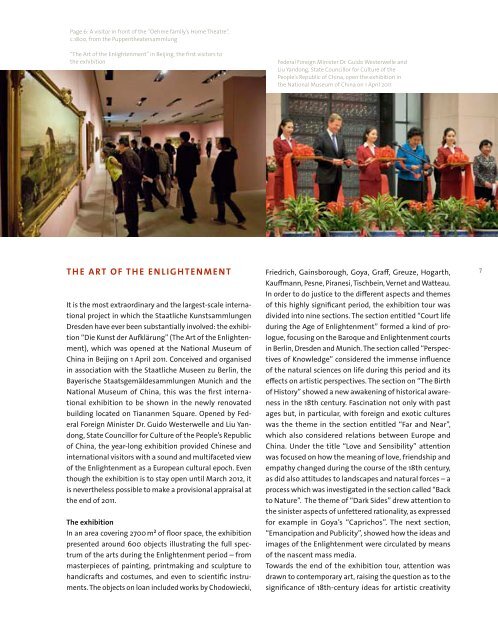2011 - Staatliche Kunstsammlungen Dresden
2011 - Staatliche Kunstsammlungen Dresden
2011 - Staatliche Kunstsammlungen Dresden
Create successful ePaper yourself
Turn your PDF publications into a flip-book with our unique Google optimized e-Paper software.
Page 6: A visitor in front of the “Oehme family’s Home Theatre”,<br />
c.1800, from the Puppentheatersammlung<br />
“The Art of the Enlightenment” in Beijing, the first visitors to<br />
the exhibition<br />
TH E ART OF TH E EN LIGHTENMENT<br />
It is the most extraordinary and the largest-scale international<br />
project in which the <strong>Staatliche</strong> <strong>Kunstsammlungen</strong><br />
<strong>Dresden</strong> have ever been substantially involved: the exhibition<br />
“Die Kunst der Aufklärung” (The Art of the Enlightenment),<br />
which was opened at the National Museum of<br />
China in Beijing on 1 April <strong>2011</strong>. Conceived and organised<br />
in association with the <strong>Staatliche</strong> Museen zu Berlin, the<br />
Bayerische Staatsgemäldesammlungen Munich and the<br />
National Museum of China, this was the first international<br />
exhibition to be shown in the newly renovated<br />
building located on Tiananmen Square. Opened by Federal<br />
Foreign Minister Dr. Guido Westerwelle and Liu Yandong,<br />
State Councillor for Culture of the People’s Republic<br />
of China, the year-long exhibition provided Chinese and<br />
international visitors with a sound and multifaceted view<br />
of the Enlightenment as a European cultural epoch. Even<br />
though the exhibition is to stay open until March 2012, it<br />
is nevertheless possible to make a provisional appraisal at<br />
the end of <strong>2011</strong>.<br />
The exhibition<br />
In an area covering 2700 m² of floor space, the exhibition<br />
presented around 600 objects illustrating the full spectrum<br />
of the arts during the Enlightenment period – from<br />
masterpieces of painting, printmaking and sculpture to<br />
handicrafts and costumes, and even to scientific instruments.<br />
The objects on loan included works by Chodowiecki,<br />
Federal Foreign Minister Dr. Guido Westerwelle and<br />
Liu Yandong, State Councillor for Culture of the<br />
People’s Republic of China, open the exhibition in<br />
the National Museum of China on 1 April <strong>2011</strong><br />
Friedrich, Gainsborough, Goya, Graff, Greuze, Hogarth,<br />
Kauffmann, Pesne, Piranesi, Tischbein, Vernet and Watteau.<br />
In order to do justice to the different aspects and themes<br />
of this highly significant period, the exhibition tour was<br />
divided into nine sections. The section entitled “Court life<br />
during the Age of Enlightenment” formed a kind of prologue,<br />
focusing on the Baroque and Enlightenment courts<br />
in Berlin, <strong>Dresden</strong> and Munich. The section called “Perspectives<br />
of Knowledge” considered the immense influence<br />
of the natural sciences on life during this period and its<br />
effects on artistic perspectives. The section on “The Birth<br />
of History” showed a new awakening of historical awareness<br />
in the 18th century. Fascination not only with past<br />
ages but, in particular, with foreign and exotic cultures<br />
was the theme in the section entitled “Far and Near”,<br />
which also considered relations between Europe and<br />
China. Under the title “Love and Sensibility” attention<br />
was focused on how the meaning of love, friendship and<br />
empathy changed during the course of the 18th century,<br />
as did also attitudes to landscapes and natural forces – a<br />
process which was investigated in the section called “Back<br />
to Nature”. The theme of “Dark Sides” drew attention to<br />
the sinister aspects of unfettered rationality, as expressed<br />
for example in Goya’s “Caprichos”. The next section,<br />
“Emancipation and Publicity”, showed how the ideas and<br />
images of the Enlightenment were circulated by means<br />
of the nascent mass media.<br />
Towards the end of the exhibition tour, attention was<br />
drawn to contemporary art, raising the question as to the<br />
significance of 18th-century ideas for artistic creativity<br />
7

















